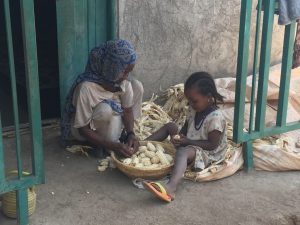A presentation on "Transitioning Prudently and Efficiently from Vitamin A (VA) Supplementation to Longer‐Term Strategies to Achieve Adequate VA Intake for Children: Model‐based Options for Cameroon and Lessons for Ethiopia" was given by Dr. Stephen Vosti of University of California in Davis at the International Livestock Research Institute (ILRI) on August 9, 2018. The study sought to identify cost‐effective combinations of Vitamin A (VA) intervention programs over a 10‐year planning time horizon in three macro‐regions (North, South, Cities) in Cameroon, while confirming adequate VA status by one or two post-intervention VA status surveys, as recommended by the Global Association for VA (GAVA).
The study used national dietary intake data to predict the nutritional benefits of alternative combinations of VA intervention programs in terms of effective coverage (achieving dietary VA adequacy) and deaths averted. Costs of programs were estimated. An economic optimization model identified the least‐cost VA strategy for each macro‐region, and a sequence of policy choices leading from the business‐as‐usual (BAU) to a more efficient strategy, confirming through VA status surveys that children at risk of VAD continue to be protected during policy transition periods. The research found that BAU programs (VA supplementation {VAS} and oil fortification) effectively cover 11.9m child years and cost $29.8m over 10 years, or $2.49 per child year effectively covered. A more efficient scenario involves investments in the national edible oil ($4.9m over 10 years) and VA‐fortified bouillon cube programs ($2.9m over 10 years), after which the fortification programs are predicted to eliminate inadequate VA intake, and thus VA‐related mortality, in the South and Cities macroregions. The same is not true for the North macro‐region, where VAS will need to continue until additional delivery platforms can be identified and implemented. For the South macro‐region, ascertainment of program impact on one or two occasions would cost $1.75m or $3.0m, respectively, to conduct the survey(s) and to maintain the VAS programs until adequate status is confirmed. Current VA intervention programs in Cameroon are effective but inefficient. Modeling identifies more cost‐effective programs; cost savings can be large. The chosen approach to confirm adequate VA status (i.e., one versus two surveys in non‐consecutive years) will greatly affect cost savings. During programmatic transitions, at‐risk children need continual twice‐annual VAS.
This presentation was organized by ESSP and EDRI. ESSP is a collaborative program undertaken by IFPRI and EDRI, whose objective is to help improve the policy-making decision process in Ethiopia.
Please subscribe to receive regular updates on ESSP’s work and its quarterly newsletter.
Keep updated with cutting edge research from Ethiopia.
